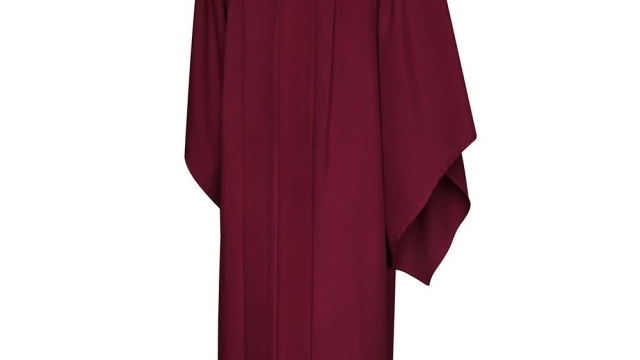
Choir robes hold a captivating allure that transports us to grand cathedrals and majestic concert halls, where harmonious melodies reverberate through the air. These elegant garments, steeped in tradition and mystique, not only serve as an outward representation of the unity and solidarity of a choir but also hold deep symbolic meaning.
Stepping into the resplendent world of choir robes, we enter a realm where aesthetics merge with functionality. Beyond their undeniable beauty, these robes serve a practical purpose, ensuring uniformity and creating a visually striking ensemble. Crafted with meticulous care, each robe becomes a vessel of elegance, draping its wearer in a cloak of grace and modesty.
The history of choir robes stretches back centuries, evolving alongside the development of choral music itself. Originally, these garments were designed to mirror the attire worn by religious clerics, imparting an air of reverence and solemnity to the individuals wearing them. Over time, choir robes became more ornate and distinct, reflecting the artistic and cultural heritage of a particular choir or institution. With the passage of time, the robes have become cherished emblems, uniting generations of singers who have stood side by side, engaging in the timeless art of choral expression.
The Significance of Choir Robes
Choir robes hold a significant role in the world of choral performance. These elegant garments not only add a touch of grace and sophistication to the singers’ appearance but also serve a deeper purpose. Choir robes are more than just clothing; they symbolize unity, tradition, and the transformation of individual voices into a harmonious blend.
The first and foremost significance of choir robes lies in their ability to unify a group of singers. Regardless of age, gender, or ethnicity, when choir members don their robes, they become part of a cohesive whole. The uniformity of the robes erases any visual distractions and allows the audience to focus solely on the beauty of the music being created. The sense of togetherness that the robes foster reinforces the idea that in a choir, every voice matters and contributes to the overall sound.
Moreover, choir robes carry a rich tradition that echoes through generations of choral performers. From the earliest religious settings to modern secular performances, the use of robes has been an integral part of choral culture. The continued use of robes connects present-day choirs with the long lineage of singers who came before them, paying homage to the art form’s history. This tradition not only instills a sense of pride and belonging in choir members but also creates a sense of reverence for the music they perform.
Finally, choir robes symbolize the transformative power of music itself. When individuals step into their robes, they shed their personal identities and become part of something much greater. The robes create a sense of equality, where the focus shifts from individuality to collective harmony. In this way, choir robes serve as a visual representation of the unique ability of music to bring people together, to uplift spirits, and to create something beautiful out of many voices.
In conclusion, choir robes carry immense significance in the world of choral performance. They not only enhance the elegance of the singers but also symbolize unity, tradition, and the transformative nature of music. By donning these robes, choir members step into a collective realm where individual voices merge to create something truly extraordinary. The mystique of choir robes remains an integral part of the choral experience, reminding us of the power of harmony and the magic that unfolds when voices unite.
History and Evolution of Choir Robes
The origins of choir robes can be traced back to ancient times. In the early centuries, religious choirs began wearing simple garments to distinguish themselves from the congregation. These early robes were often plain and made of basic fabrics like linen or wool.
As centuries passed, choir robes underwent various transformations. During the medieval period, elaborate designs and decorative elements were incorporated into the garments. Colors became significant, with different hues representing different religious seasons and events. Embroidery and intricate patterns adorned the robes, adding an air of elegance and reverence to the choir’s appearance.
It was not until the 16th century that choir robes started to take on a standardized form. The Protestant Reformation brought about a shift in the design of church attire. Reformers advocated for simplicity and a departure from the ornate garments of the Catholic Church. This led to the adoption of plain black robes, emphasizing the focus on the word of God rather than the extravagance of attire.
In modern times, choir robes have continued to evolve. While some choirs still choose traditional styles, others have embraced contemporary designs and materials. The use of lightweight fabrics, innovative cuts, and modern colors has brought a fresh perspective to the world of choir robes. Regardless of the specific style chosen, the purpose remains the same – to create a sense of unity, elegance, and reverence among the choir members, enhancing their collective performance and creating a visually captivating experience for the audience.
Design and Symbolism of Choir Robes
Choir robes have long been a rich source of design and symbolism, embodying the essence of elegance and tradition. The careful attention to detail in the design of these robes reflects the significance and reverence associated with choral performances.
The color palette chosen for choir robes plays a vital role in conveying various meanings. The use of white robes, for instance, symbolizes purity and a sense of divine presence. They evoke a sense of serenity and create a visually unified ensemble, allowing the focus to remain on the collective harmony of voices.
Additionally, the cut and style of choir robes also hold symbolic importance. The flowing nature of the robes amplifies the grace and fluidity of the singers’ movements. The loose sleeves allow for unrestricted arm movements, enabling the singers to express themselves fully, unencumbered by any physical constraints.
Furthermore, the inclusion of special embellishments enhances the overall aesthetic and symbolism of choir robes. Embroidered patterns or symbols on the robes can represent the particular traditions or beliefs of the choir, adding a personal touch to their performances. These details not only contribute to the visual appeal but also serve as a reminder of the choir’s unique identity and purpose.
In conclusion, choir robes are not simply garments worn by singers but rather artistic representations of the beauty and significance of choral performances. The design, color, and symbolic elements all work together harmoniously to create an atmosphere of elegance, enhancing the overall experience for both the performers and the audience.



